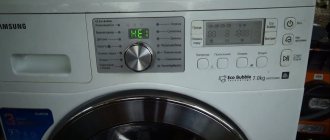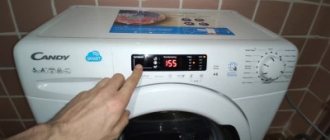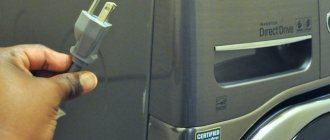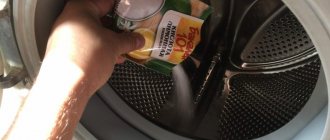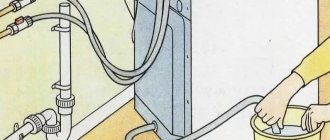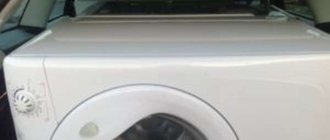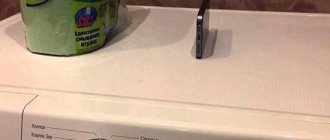The Indesid washing machine is the most common model in the budget segment. It is very popular among the broad masses of the population not only in the Russian Federation, but also in many foreign countries. The equipment performs its functions perfectly, providing many washing modes, including delicate washing, ending with sports equipment.
But given the fact that it belongs to the budget class, its service life is not so long. This is due to the quality of installation, the parts used during the production process and the skill of manufacturing the electronic control board.
The Indesid washing machine quite often requires the intervention of specialists to carry out any repair operations or adjust operating modes, but the cost of these services is very high. Repairing a washing machine yourself is much cheaper, but how to disassemble an Indesit washing machine? It is this question that we will try to answer in this article.
Video
How to disassemble an Indesit washing machine is described in more detail in the video below.
About the author:
Mom, wife and just a happy woman. She draws inspiration from travel and cannot imagine life without books and good films. She strives to become an ideal housewife and is always ready to share her experience.
Found a mistake? Select it and click the buttons:
Ctrl + Enter
Interesting!
For washing small items on the road or in a hotel, it is convenient to use a regular plastic bag. Socks or tights are kneaded inside a tied bag along with water and a small amount of detergent. This method allows you to pre-soak things and wash them without damaging the fabric or wasting a lot of powder and water.
Possible difficulties when removing the tank and ways to eliminate them
A welded, non-separable tank is a problem that can only be discovered after the washing machine has been disassembled piece by piece. Cutting the tank along the soldering line with a hacksaw will help eliminate the difficulties.
Algorithm of actions:
- Carefully inspect the plastic tank and mark a cutting line along the factory weld seam.
- Holes are drilled along the marked line (steps of 4-5 cm).
- Use a hacksaw to cut the tank.
- Remove the wheel securing the drum with the plastic body.
- Remove the drum.
After installing the new drum, the plastic body of the non-separable tank is connected (the edges are pre-coated with sealant) and fixed with bolts and nuts (the connection points are drilled in advance).
During the process, the hacksaw must be kept as straight as possible. The slightest misalignment in any direction increases the risk of leaks of the assembled tank in the future.
It is not recommended to cut the tank with a hacksaw (it leaves a rough, sloppy cut). It is forbidden to use an angle grinder (there is a high risk of damage to the part).
Replacing a faulty pump with a new one
To replace a broken pump, it is not necessary to seek the services of a specialist. You can do the work yourself, following the recommendations described above.
This is not at all difficult, the main thing is to take precautions and install the terminals and connections in the same way as they were placed before
To carry out the work, you will need a complete drain pump, impeller, cuff, axle, pulley, sensor, all necessary contacts and gasket. The tools used are a Phillips screwdriver, a knife and a multimeter to measure voltage.
Replacing the pump on a top-loading washing machine
The top-loading machine design allows access to internal parts through the rear cover. In this case, you must act very carefully, since there are boards and functional parts on it. Otherwise, the step-by-step execution of the work fully corresponds to the “horizontal” models:
- Unscrew the screws along the edges of the cover and remove it;
- remove all the bolts that are responsible for fastening the rear panel;
- If it is necessary to remove the side wall, you must also first unscrew the bolts. They can be in front or behind the machine body;
- Unscrew the pipe clamp on the drain; if it is secured with a screw, it should also be unscrewed;
- disconnect the pipe and all wiring connectors;
- remove the outlet valve and drain the water;
- Unscrew the screws that secure the pump and remove it. Install a new part;
- connect the contacts and put everything back together.
Replacing the pump on washing machines of German brands
Well-known German manufacturers such as AEG, Kaiser, Bosch, Miele and Siemens are renowned for their durability and excellent performance. But if a problem occurs with the drain pump, getting to it is not so easy. To do this, you must strictly follow the following instructions:
- Unscrew the two screws from the back, slightly move the top cover forward and remove it.
- Carefully remove the detergent tray, taking into account its design features.
- Unscrew all screws located around the perimeter of the panel. Unfasten the plastic latches using a flathead screwdriver or any other convenient tool.
- The disconnected panel can be carefully removed to the top without disconnecting the wires, or hung on a special service hook.
- Disconnect the latches of the lower plinth panel, which is located under the hatch.
- Open the hatch door, bend the rubber cuff, pry the clamp with a screwdriver and remove it. For convenience, the cuff should be tucked inside the tank.
- Place your hand behind the body in the place where the hatch lock is located and disconnect the wiring.
- Unscrew the fasteners that hold the front cover of the machine, slide it and remove it. Then access to the pump is open. In some washing machines, the drain pump can be removed by turning it counterclockwise.
Lock device
Note that there are a large number of variations of locks. Manufacturers of washing machines install different locks on their models, which differ in shape, size, and method of fastening. They also differ in their operating principles. There are mainly two types used:
thermal;
electronic.
One of the UBL options
Thermal UBL
At the heart of the thermal lock is an RTS resistor and (or) a bimetallic plate. After closing the hatch and starting the washing program, a voltage of 220 volts is supplied to the resistor. It begins to heat up quickly and simultaneously heats the plate, which bends.
As a result, it blocks the hatch hook using a latch, preventing it from opening during the wash cycle. The bimetallic plate also closes the control contact, as a result of which the selected program begins to be executed.
The diagram and principle of operation of such a lock is shown in the figure below.
Note that markings in the form of letters: N, L and C are often present on the UBL contacts, which makes it easier to check. Instead of an RTS thermistor, a winding made of high-resistance wire can be used. And also two resistors are used in some models, which does not change the principle of operation.
Let us repeat that locks vary in shape, size and fastening, and if you need to purchase them, you need to select them according to the product number of the machine.
Simple thermal lock
This type of lock opens itself after the wash is completed. This is both a plus and a minus. The main disadvantage is that the opening takes place after 2-3 minutes, since the bimetallic plate needs time to cool and take its original shape, thereby releasing the tongue that holds the door. Most washing machines have a light indicator for holding the hatch.
Expert opinion
I work in the household appliance repair industry. Extensive experience in restoring washing machines and dishwashers.
Ask a Question
Important! Neglecting the cooling time leads to breakage of the lock mate, which is located directly in the door. Such UBLs are used in inexpensive models “Indesit”, “Ariston”, “Beko”, “LGi”, “Samsung”, “Ardo”, “Whirlpool”
Such UBLs are used in inexpensive models “Indesit”, “Ariston”, “Beko”, “LGi”, “Samsung”, “Ardo”, “Whirlpool”.
Electronic lock
An electromagnet is added to such a locking device, which is controlled by pulses coming from the module. And also in such UBLs there may also be an RTS resistor. In this case, the thermistor with a bimetallic plate closes the control wire, and the electromagnet moves the latch that blocks the hatch.
The castle is shown schematically in the figure below.
Such devices are installed on models of the mid-price level and above, such as: Electrolux, Zanussi, Kandy, Bosch, Siemens, AEG. There is only one drawback: the verification is difficult.
A hatch with such a UBL can be opened only if the following conditions are met:
- the machine is connected to the electrical network;
- none of the programs are running;
- there is no water in the drum;
- The engine does not rotate.
Note that washing machines with such locks are equipped with emergency opening devices, which are usually located in the area of the drain pump filter cover.
Burnt electronic lock
Vertical loading
Top-loading appliances are very convenient in rooms with limited space. The service life of the drum in a washing machine of this type increases several times, since it is secured on both sides. Accordingly, its disassembly will be slightly different from the previous version:
- Unscrew all the screws from the bottom front and on the back wall.
- The side panel is removed.
- All wires are removed, after which the remaining screws are unscrewed.
Sometimes the plastic cover can be tightly soldered; you will have to get rid of it with a drill. As for the second side panel, it must be removed in the same way as the first. After all this, the screw that secures the shaft is removed and the drum is removed.
How to remove the drum
There are many brands of washing devices. The most famous are: LG, Samsung, Whirlpool, Indesit, Zanussi, Bosch, Kaiser. Each of them has design features, but the main elements, as well as their location, are almost the same. For this reason, the procedure for disassembling will be approximately the same.
Removing fasteners
Removing the drum, as well as other repair work on the unit, begins from the top panel. As a rule, the bolts for fastening the latter are located on the rear side. But it happens that they are found on the sides.
The back panel is removed after unscrewing the screws that hold it in place. To separate the drive belt, you need to carefully rotate the pulley wheel in a clockwise direction.
The dashboard is secured with screws located in the niche of the detergent tray.
Before dismantling the front cover, the hatch door is removed and the rubber cuff is disconnected. Then, after unscrewing several fixing screws, the front panel is carefully removed.
Removing parts
To release the upper part of the tank, it is necessary to remove the pipe, counterweight, water intake valve, and pressure switch.
In the lower part, the heating element, engine, drain pipe, lower counterweight, and shock absorbers are removed. In most devices, the heating element is located under the tank. To remove it, the contacts are disconnected and the nut, which has a central location, is unscrewed.
Unscrewing the “stones” is done very carefully so as not to accidentally drop them on the body of the washing machine or on your feet. To remove the electric motor, you need to remove the power plug and grounding wire from it, and only then unscrew the mounting bolts (usually four)
To remove the drain pipe and shock absorbers, place the machine on its side. Using pliers, the clamp is removed and the pipe is disconnected from the pump. Only then are the shock absorber mounts unscrewed and the tank freed from the hooks. To dismantle the pipe, loosen and remove the clamps that hold it
To remove the electric motor, you need to remove the power plug and grounding wire from it, and only then unscrew the mounting bolts (usually four). To remove the drain pipe and shock absorbers, place the machine on its side. Using pliers, the clamp is removed and the pipe is disconnected from the pump. Only then are the shock absorber mounts unscrewed and the tank freed from the hooks. To dismantle the pipe, the clamps that hold it are loosened and removed.
After completing all the procedures described above, the tank can be removed from the body of the washing unit.
Removing the tank alone will not be easy. It is best to perform this procedure with a partner. One person must neutralize the springs, and the other must remove the tank. In addition, you should be very careful, since the part is heavy and easy to drop.
Pulling out the drum
It is possible to remove the drum from the “remains” of the tank only after unscrewing it (with a wrench) and removing the pulley. Then return the bolt that held the pulley to its original position (all the way). Finally, using a hammer to lightly tap the shaft, tap the drum out of the tank.
If the washing device is to be reassembled, it is recommended to carefully check the integrity of the bearings and replace them if necessary. It is imperative to install a new oil seal and treat it with lubricant.
When thoroughly disassembling the washing machine, you need to check all its parts for functionality. An ordinary tester will help assess the condition of all electronics. A visual inspection will also be helpful. You should definitely take a closer look at the heating element: if there is scale, it is recommended to clean or replace it.
What are filters for and where are they located?
Not all users know that some parts of the washing machine need cleaning. If this is not done, an error code is displayed on the display indicating a blockage in the system. The inlet filter is installed immediately behind the inlet hose. It protects the intake valve and other elements from debris that enters the line. And this: fine debris, sand, rust.
The drainage or drain filter is a base with a mesh or plastic grid. It protects the pump and drain path from large debris. Most often, the latter gets there along with clothes. These are items forgotten in pockets, buttons, clothing decorative elements, bra underwires. It is located at the bottom of the front panel.
How do you know when it’s time to unscrew and clean the parts? Pay attention to external signs:
- Water is not filling into the tank.
- The machine stops during the rinsing or spinning phase.
- Water leaves the tank poorly or not at all.
Are the symptoms familiar? Then learn how to remove and remove debris from the guard.
How to unscrew and clean the water filter?
So, we found out that the part is installed behind the intake hose. Proceed sequentially:
- Disconnect the automatic washing machine (CMA) from the network.
- Close the inlet valve.
- Move the washer body slightly away from the wall.
- Place the container and unscrew the hose from the body.
- Direct it into a container to drain the water.
- Using pliers, remove the filter mesh.
The degree of contamination of the mesh depends on the hardness of the water in your region. The presence or absence of an additional barrier between the washing machine and tap liquid also affects. If simply rinsing the part under the tap is not enough, soak it in a solution of water and citric acid. You can also remove dirt with a brush and soda. Once the filter cleaning is complete, reconnect.
Methods for determining failure
First of all, you need to determine what kind of breakdown occurred. An initial diagnosis will help you decide whether it is possible to fix the problem yourself or whether you will still have to spend money on professional repairs.
The right step would be to first familiarize yourself with the circuit diagram of the washing machine in order to have an idea of where everything is located.
In many cases, a breakdown in the Indesit washing machine can be repaired with your own hands. But to do this, you at least need to familiarize yourself with the design of the machine.
Sometimes, to determine the cause of the failure of household appliances, it is enough to read the instructions for use, which, among other things, contain recommendations for eliminating breakdowns.
The first thing you need to do is look at the display. If it is impossible to complete the specified process, the washing machine displays special codes on the display.
Models of Indesit washing machines produced in recent years are equipped with displays, the signals of which will be the first to report the occurrence of a malfunction
Error codes in the operation of the washing machine are given in the instructions that the manufacturer necessarily attaches to its product:
- F01 – in the control of the drive motor the triac semiconductor device is closed;
- F02 - due to an open circuit or short circuit, the tachogenerator has lost the ability to signal the rotation of the drive motor, another reason for such an error is the motor is blocked;
- F03 – the temperature sensor circuit has been short-circuited or broken;
- F04 – failure of the water level sensor;
- F05 – due to an interruption in the operation of the drain pump, a clogged drain tract, or a malfunction of the water sensor, the “empty tank” signal is not given;
- F06 – due to errors in the front panel buttons, the program code is not defined;
- F07 – the heating element does not heat up;
- F08 – faulty wiring, relay or tubular electric heater itself;
- F09 – EEPROM memory has failed;
- F10 – the water level sensor suddenly lost signals of both a full and an empty tank;
- F11 – the supply voltage has disappeared in the drain pump;
- F12 – communication between the controller and the display module is broken;
- F13 – open or short circuit in the sensor circuit responsible for the drying temperature;
- F14 – malfunction in the drying heating element;
- F15 – damage to the heating element relay responsible for drying;
- F16 – drum blocking;
- F17 – power is not supplied to the hatch door lock or they forgot to close it;
- F18 – on the main electronic module there was a communication error between the controller chips and the processor that controls the asynchronous drive motor.
A complete explanation of error codes in the operation of Indesit washing machines and ways to eliminate violations will be provided in an article entirely devoted to these important issues.
It is possible to check various contacts, wiring, sensors using a very useful device - a multimeter. The device will show whether there is power everywhere.
If you have dealt with electrical repairs before and know how to use a multimeter, it will help clarify the situation and point out some errors
Sometimes it is enough to listen to the sound made by the unit. When the washing machine begins to creak, make excessive noise, and sometimes even rumble, then, most likely, problems have arisen in the bearings or drum, the oil seal is damaged, the counterweight fasteners are loose, and the shock absorbers are in poor condition.
Hatch locking device
When starting to check, it is important to understand what type of lock is installed in your model of automatic washing machine (WMA). In older SM releases, manufacturers installed blockers with an electromagnet. However, they were ineffective without electricity
If the electricity was turned off during washing, the hatch automatically unlocked
However, they were ineffective without electricity. If the electricity was turned off during washing, the hatch automatically unlocked.
Another thing is the hatch door lock based on bimetallic plates. They are used everywhere due to their efficient operation.
The structure consists of three main elements:
- thermoelement;
- bimetallic plate;
- fixing device.
How does UBL work? Everything is tied to electronics. The electronic board supplies current to the thermocouple, which heats up quickly. This, in turn, is applied to the plate, which, increasing in size, pushes out the latch. Typically, when you start a cycle, you will hear a click, which means the door is locked and ready to draw water.
The principle of operation of the lock has been disassembled. Now let's talk about its problems: for what reasons does a breakdown occur?
Reasons for the malfunction of the lock in the washing machine
There are two main causes of breakdowns: physical wear and tear and electronic problems.
- Constant deformation of the plates when heated leads to damage and destruction of the element. In such cases, fixation does not work at all.
- Power surges in the network can lead to breakdown of the thermoelement. Then it does not heat up, therefore, the plate remains in place. The short circuit of the control triac results in the door not opening. Current is continuously supplied to the parts, so the latch does not turn off.
What should I do if there is a problem? Check the lock of the washing machine and replace it if it is faulty.
How to check the UBL of a washing machine with a tester?
The first thing that catches your eye when a breakdown occurs is the abnormal operation of the equipment. Here are the signs that indicate problems with UBL:
- The hatch does not open even several hours after the wash is finished.
- A code was displayed on the display of the washing machine, which indicates a problem with the blocker.
- The door will not unlock even after disconnecting the appliance from the power supply.
- During startup, the lock does not work and the hatch does not close.
Most often, either the element itself or its wiring and control module fail. A multimeter will help you accurately determine the cause of the breakdown.
To perform diagnostics, you will need the electrical diagram of the device. It may be different for each model, because manufacturers arrange the contacts differently.
What you need to find out:
- Where is the “neutral” contact located?
- Where is "general" located?
- Where is the “phase” located?
Prepare a multimeter and adjust it to measure resistance. You can get to the lock the same way in all front models:
- Open the door.
- Unscrew the two mounting bolts.
- Bend down the sealing collar.
- Place your hand behind your body.
- Get the UBL.
- Disconnect the wiring.
Now place one tester probe on the neutral contact and the other on the phase contact. Three-digit values are considered normal.
Next, place one probe against the neutral contact, and the other against the common one. The device is considered broken if the values are 1 or 0.
The tester did not find a fault, but the lock does not work? Inspect the lock itself; perhaps the reason is the wear of the bimetallic element. The lock cannot be repaired; it must be replaced immediately. Buy an identical part from the store, connect the wires and install it in its original place. Watch the video for details:
How to perform diagnostics if the sunroof is blocked? There is an easy way to open it:
- Take a thin ribbon.
- Pass it between the door and the SMA body.
- Pull firmly on both ends.
- The latch should give way.
Lastly, the control board is inspected. Its triacs often suffer from oxidation and burns. The reason for this is unstable voltage in the network and high humidity in the room. It is better to entrust module repair to a specialist.
To maintain the functionality of the washing machine electronics, connect the equipment through a voltage stabilizer. Before starting repairs, unplug the plug from the outlet.
Bad7
Interesting18
Super
Disassembling the Indesit washing machine
There are points that you need to know when disassembling any model of washing machine.
First, and this is the main thing to remember, turn off the power and water supply.
Secondly, you need to prepare all the tools and parts that will be needed during the repair.
And thirdly, you need to know the cause and location of the breakdown.
The work will require 3-4 hours of free time. You may need help at the stage of removing the tank from the car, because the process is labor-intensive and you will need to lift approximately 30 kg to a height of about a meter.
Let's start with choosing a place for repairs
This can be any room, with the possibility of free access to all sides of the machine, as well as tilting the equipment and free space for the removed tank. A 2x2 space will be enough to freely disassemble the indesit.
It would be nice not to stain the floor, so it is better to cover it with rags and newspapers.
Preparing for work
Before use, remove the machine filter and drain the remaining water.
It’s good if you keep a photo report of the stages of your work so that you can tell others how to disassemble an indesit machine.
However, the most important thing for which photographs are needed is so that later there will be no problems when assembling the equipment.
Working with the body
You need to remove the back cover
- We remove it by unscrewing 6 screws. It would be nice if all the screws and small parts were put into a box, for example. You will need tools: screwdrivers, wrench and pliers.
- Looking under the back cover, the star screw on the wheel and on the lower weight catches your eye. If you have the right tools, these parts can be removed to lighten the weight of the tank. Otherwise, you can leave and take out the tank with them.
- Now remove the top of the machine by unscrewing two screws. The lid must be pulled towards you so that it comes out of the grooves and set aside. Three screws with 10mm heads hold the top weight very tightly, we take it out too. You will have to strain to unscrew the screws.
- We remove the front panel, which is held on by only two screws.
- Take out the detergent tray. You need to lift it up and pull it out, shaking it left and right. We found three screws, which we also unscrew.
All electrics inside turn off
- You need to disconnect the wire coming from the front panel to the board.
- The powder receptacle is a large part the width of the entire machine. You will see two wires - blue and white. We disconnect them, but you need to remember which one is inserted where.
- Where the water is supplied, there is a screw that we also unscrew. A tube is attached to the bottom of the powder receiver using a rubber eyelet. We also remove it; to do this, the eye is pryed off and the pipe is pulled down. That's it, the part can be put aside.
- Now let's disconnect the power cord. You need to find the rectangular piece to which it is attached, unscrew the screw and pull it out of the grooves by pulling it up.
- Between the tank and the hatch there is rubber, which is supported by a spring. To remove it, just push the rubber up and grab the spring from the top from inside the car.
Removing the heating device
- It is secured with clamps that need to be disconnected along with the wires (wires leading to the motor, a bunch of wires under the shade).
- Unscrew the nut and remove the heating element. It happens that it is not very easy to get it, since it fits very tightly!
- It's time to put the machine upside down. It’s better not completely upside down, but at an angle of about 45 degrees.
- From below, you need to unscrew the bolts on both sides on which the shock absorbers are attached. After this, the tank is held in place only by the upper springs.
- We return the car to its original position.
- It's time to take out the plastic tank. Help won't hurt, because you still need to remove the springs.
Attention! The hatch cover must be open, otherwise it will interfere with the process of emptying the tank.
It's just a matter of little things and we can assume that we have managed to disassemble the indesit washing machine.
Remaining works
- We remove the shock absorbers attached to the tank on plastic pins. To pull them out, you need to lightly squeeze them with pliers.
- Next, remove the motor and rubber pipe.
- To further work with the tank, you will need to remove the lower weight.
We list possible malfunctions
You can’t wash things dry in a machine, so you can’t put off solving the problem with filling - it’s better to immediately start looking for a possible cause. Fortunately, an empty drum does not always indicate a breakdown; sometimes it is due to a missing central water supply or a blocked water supply.
There is a third “non-repairable” reason - a door that is not tightly locked. Before washing, the control board must ensure that the drum is sealed. If the hatch is not slammed shut, the electronic lock does not work, which means the system rejects the start of the cycle.
Quite often, quite noticeable breakdowns and malfunctions lead to problems with water supply. The difficulty of diagnostics is that their list is long: from the inlet valve to hoses and the control module. So, users often encounter eight problems.
- Damaged intake valve. This device controls the water supply to the machine. If it fails, the membrane stops responding to the signal supplied by the board - the “entrance” to the machine will remain locked. Confirming a valve sensor malfunction is simple: just connect to the power supply and apply voltage to it. A working system will close and make a characteristic click, while a broken one will remain silent.
- Clogged filter mesh. The Zanussi inlet hose has a special filter attachment, on which a noticeable part of the dirt and impurities found in tap water settles. Naturally, over time, the part becomes too clogged and does not allow the water flow to pass into the machine under the necessary pressure. In this case, the machine hums when trying to fill the drum, but to no avail.
- Overfilled inlet filter. Like the mesh, the coarse filter, which was installed even earlier - right in the water pipe - also suffers from dirty water. This is where the main “dirty” impact comes in, and without regular cleaning, a blockage is possible, followed by stopping the intake into the machine.
- Broken pressure switch. This is a water level sensor, which controls the degree of filling of the drum. If the device fails, the electronic unit, not receiving information about the fill, shuts down the system for safety reasons and to prevent leakage. To test the pressure switch, you need to remove the top cover of the case, find the device, unscrew the bolts holding it, remove it and blow into the tube. There should be a few clicks in response to the air flow. Their absence will prove the fact of breakdown or blockage.
- Problems with the pressure switch hose. Sometimes it is not the sensor itself that fails, but the pipe connected to it. It becomes damaged, leaks and prevents the device from monitoring the water level in the drum.
- Problems with the inlet hose. If the sleeve is crushed by the body or broken, then the water will not be able to reach the machine.
- Non-functional pump. Before collecting a portion of clean water, the machine always drains some of the old water remaining in the tank after the previous wash. If the pump cannot pump out liquid, then the board does not give the command to fill.
- "Hung" control board. It is the electronic module that is responsible for issuing commands and collecting information from the main components of the washing machine. If there is a problem in a block with triacs, microcircuits or tracks, the system cannot cope with the task and stops Zanussi.
Modern Zanussi machines make it easier for the user to find the cause by displaying an error code on the display after automatic self-diagnosis of the system. In this case, you just need to remember the combination that is displayed and decipher it according to the instructions. The rest will have to look for the breakdown manually, checking all the problems leading to an empty drum.
First stage
What's next? And then we will need to resolve the issue with the workplace, namely where we will disassemble the washing machine and lay out the disassembled parts so as not to lose anything necessary. The ideal place is a workshop, or at least a barn or garage. If there is neither one nor the other, nor the third, then you will have to disassemble the car right in the apartment, you just need to properly prepare the place.
- Clear a 2x2 meter section of the floor from carpets and other furnishings.
- Cover an area of the floor with rags and newspapers.
- Unplug the washing machine and drag it to the disassembly site.
- Remove the powder cuvette and set it aside.
- Unscrew the garbage filter with your own hands and drain the remaining water from the tank. Place the filter aside.
The tools, work place and Indesit machine are prepared, you can begin the analysis. First, remove the upper part of the machine body, namely the cover. There are two self-tapping screws at the back in the upper right and left corners of the washing machine; they need to be unscrewed with a Phillips screwdriver. Then we slide the lid back towards us and lift it up.
Next, we will remove the service hatch cover with our own hands. It is located on the back wall of the Indesit washing machine; to do this, you will need to unscrew the 6 screws that hold it.
How to get to the tank?
By opening the service hatch and the top cover, we immediately gain access to some parts of the washing machine; this must be taken advantage of.
Remove the belt from the pulley. To do this, you need to grab the drum pulley with one hand, the belt with the other, and twist the pulley - the belt will “jump off”.
We pull the wires from the contacts of the heating element and the temperature sensor, unscrew the central nut and carefully pull out the heating element
You can leave the heating element in the tank for now, but then you need to be very careful when disassembling it so as not to break off one of the protruding contacts. Removing wires and chips from the washing machine motor
Take a 10 mm wrench and a 10 mm socket, or a long 10 mm socket wrench and unscrew the two bolts that secure the motor
We remove the wires with chips from the washing machine motor. Take a 10 mm wrench and a 10 mm socket, or a long 10 mm socket wrench and unscrew the two bolts that secure the motor
We remove the engine and put it aside. Let's go upstairs. A heavy counterweight is attached to three bolts above the top wall of the tank; it must be removed. We take the same socket wrench and unscrew these bolts with our own hands, and then pull off the counterweight and move it to the side. When disassembling, be careful not to drop the counterweight on your foot.
Our tank is almost empty, there are some small things left, for example, removing the control panel. First, we unscrew the fasteners located near the niche for the powder receptacle. Then we unscrew another screw from the left front corner of the case. Now the control panel is held in place only by relatively weak latches.
We pull the panel up, and it safely pops out of the latches. In this case, the craftsmen have only one wish - do not pull the panel too sharply, otherwise you will tear off the wires and add problems to the Indesit washing machine. We disconnect the wires going to the intake valve and remove the control panel to the side, let it hang from the edge on the remaining wires.
Let's get to work on the hatch cuff. This large elastic band is secured with a special clamp; it must be removed without piercing the cuff. What are we doing?
- Find the cuff clamp.
- Carefully pry it up with a flat screwdriver.
- We go around the circle and find the mount.
- Unscrew the fastening and remove the clamp.
- We tuck the cuff deeper into the machine body.
What do we do next? And then we go around the back of the washing machine and unscrew the screw in the area where the inlet hose is connected to the machine. After this, we will be able to immediately pull out the inlet valve along with the powder receiver niche.
Disconnect the wires from the water level sensor and remove the sensor itself from the plastic mount. At the same time, be extremely careful not to damage the mount itself and the sensor, otherwise you will have to buy and replace these elements; they still need to be found.
Now we place the washing machine on its left side. The Indesit washing machine has no bottom, so we immediately get access to the drain pipe and racks. It is these elements that will prevent us from removing the tank in the future, which means they need to be removed, without this further disassembly is impossible.
- We remove the two clamps that secure the drain pipe.
- We pull off the pipe.
- Using a 10 mm socket wrench, unscrew the screws that hold the posts in place and remove them.
- We put the car “on its feet” and we can consider that we have completed the main stage of disassembly; all that remains is to remove and disassemble the tank.
List of required tools
- First, prepare the necessary tools. Everyone has most of them in their home; if one of them is missing, they turn to neighbors for help or go to the store.
- Then a well-lit, spacious place is prepared, the floor is covered with rags or paper so as not to lose small parts and bolts.
For disassembly you will need:
- a screwdriver with a set of bits or a set of Phillips screwdrivers;
- wrench;
- flat screwdriver;
- hexagonal wrench 8 mm;
- multimeter;
- pliers, pliers;
- hammer;
- colored markers;
- transparent sealant;
- CV joint lubricants, VD-40;
- clean rags.
When cutting a tank, a fine-toothed hacksaw, a drill with a long drill bit, bolts or self-tapping screws, and a sealant gun will be useful. It is advisable to stock up on tools in advance.
How to disassemble a soldered tank
Why do manufacturers still use one-piece plastic drum shells? The answer is simple: this technology simplifies and reduces the cost of production. In addition, it is beneficial for them to use this type of tank due to the fact that if the bearing assembly wears out, the consumer will most likely purchase a new washing machine rather than choose to pay for repairs that cost almost the same as a new device.
Therefore, this trick is often used: the body is sawed, the necessary replacements are made, and it is glued back together with special glue. Here's how to describe this process.
- In front of you is a plastic tank of a machine with a drum inside. Inspect it to determine the location of the weld. To mark the sawing site, make small indentations around the entire circumference. Use a drill with a thin drill bit for this.
- Armed with a hacksaw for cutting metal, begin to carefully cut the tank along the prepared marks. Separate the cut section from the drum.
- When you turn the drum over, you can see the wheel that connects the parts together. Remove it and you will finally be able to free the drum from the body.
- After the new parts are installed, the two halves of the disassembled tank can be glued together with silicone sealant, and additional screws can be installed.
Thus, now you have the opportunity to carry out repair work yourself and save on service costs.
Which bearings and oil seal are suitable for Indesit washing machines
When replacing new seals and bearings for an Indesit washing machine, they must be of exactly the same brand and marking as the failed ones. What to do if there is no necessary information about the standard size of oil seals and bearings? Don't experiment. Masters recommend that before purchasing new parts, remove old ones from the unit, on which their markings will be visible.
As a rule, the Indesit machine is equipped with 2 single-row sealed ball bearings ZVL 6204-2RSR and ZVL 6205-2RSR (one is an order of magnitude larger than the other) and 1 sealing gland.
You should replace the drum bearing in the Indesit washing machine yourself at the same time as the cuff. Otherwise, it is possible that the repair process will not give the desired positive result.
What will you need?
Indesit washing machines are very similar in design to Ariston washing machines, but there is a difference between them and this difference, as always, is in the nuances. If you are interested in the process of disassembling an Ariston washing machine, you can read about it in one of our publications. But let’s not get ahead of ourselves, but first look at what tools we need for the job. In general, we can get by with a small suitcase with tools containing:
- open-end wrenches from 8 to 18 mm;
- set of heads and knobs;
- pliers;
- mites;
- screwdrivers of different configurations and sizes;
- a small set of socket wrenches;
- multimeter;
- hammer;
- hacksaw for metal;
- colored markers;
- awl.
If you don’t need to repair electrical equipment, then you can skip the multimeter and get by with a regular tester, and even then, just in case.
Having collected all the above tools, you can proceed to the next stage of preparation for work.

